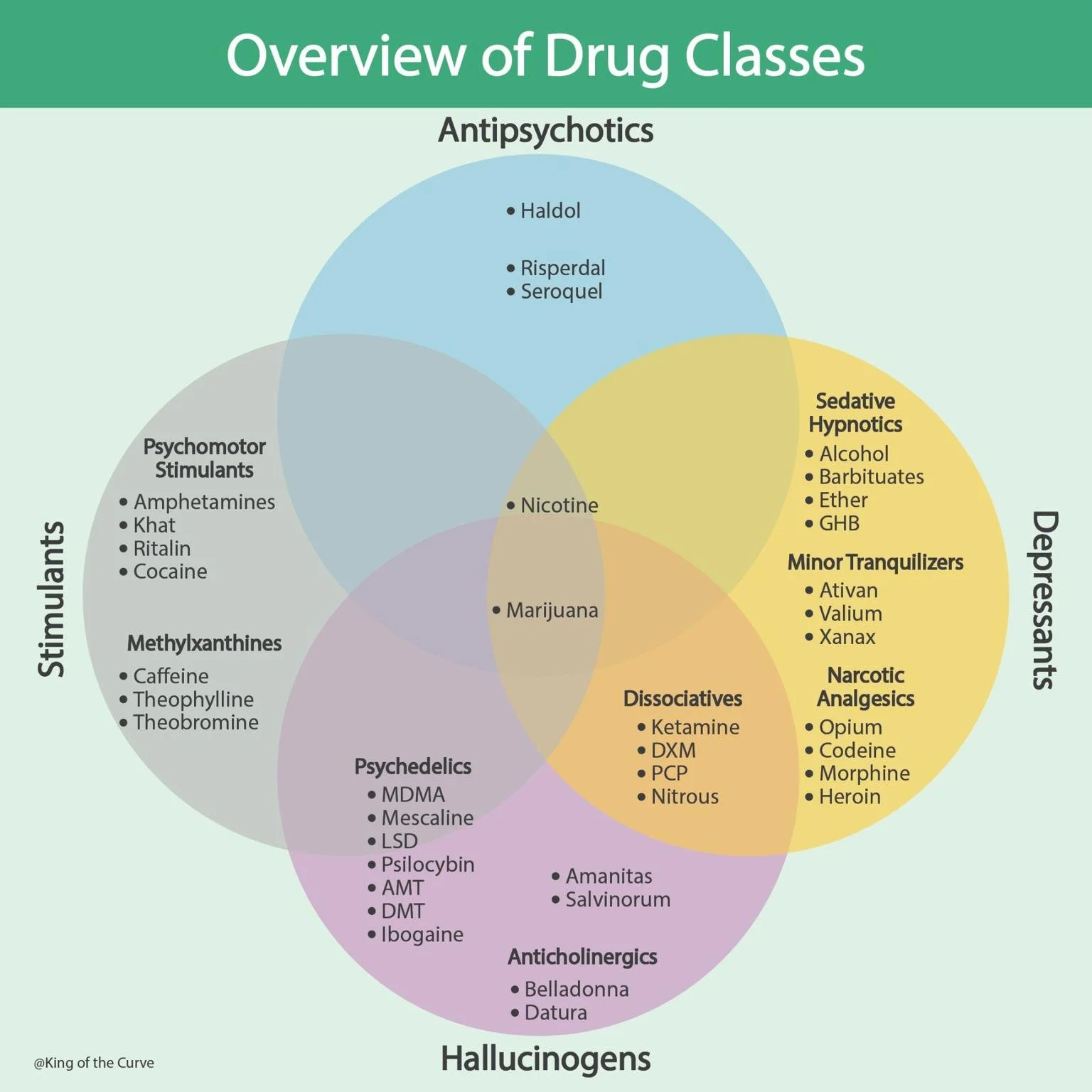🧠 Overview of Drug Classes: Understanding Their Effects and Interactions
Drugs affect the human body in complex ways, influencing mood, perception, and behavior. To understand their diverse effects, pharmacologists classify drugs into broad categories based on their mechanism of action, therapeutic use, and effects on the central nervous system (CNS). The primary drug classes include stimulants, depressants, antipsychotics, and hallucinogens, each with distinct properties and risks.
⚡ Stimulants: The Energy Boosters
Stimulants increase activity in the CNS, leading to heightened alertness, focus, and energy. They are often used medically to treat conditions like ADHD or narcolepsy but can be addictive when misused.
Common stimulant subclasses include:
Psychomotor Stimulants (e.g., amphetamines, cocaine, Ritalin) — increase dopamine levels and elevate mood.
Methylxanthines (e.g., caffeine, theophylline, theobromine) — mild stimulants found in coffee, tea, and chocolate that block adenosine receptors.
💤 Depressants: Slowing Down the System
Depressants reduce CNS activity, promoting relaxation, drowsiness, and sedation. While some are used therapeutically to manage anxiety or insomnia, misuse can lead to respiratory depression and dependence.
Subclasses include:
Sedative-Hypnotics (e.g., barbiturates, alcohol, GHB) — often used to induce sleep or anesthesia.
Minor Tranquilizers (e.g., benzodiazepines like Xanax and Valium) — help manage anxiety and panic disorders.
Narcotic Analgesics (e.g., morphine, codeine, heroin) — potent painkillers with high addiction potential.
🌈 Hallucinogens: Altering Perception
Hallucinogens change sensory perception and cognitive processes. They are divided into several types, each affecting neurotransmitters differently.
Psychedelics (e.g., LSD, psilocybin, mescaline) — alter mood, thought, and sensory experiences.
Dissociatives (e.g., ketamine, PCP, DXM) — cause a feeling of detachment from the body or environment.
Anticholinergics (e.g., belladonna, datura) — block acetylcholine and can induce delirium or hallucinations.
⚖️ Antipsychotics and Their Role
Antipsychotics (e.g., Haldol, Risperdal, Seroquel) are medications used to manage psychiatric conditions like schizophrenia and bipolar disorder. They work by modulating dopamine receptors to reduce hallucinations, delusions, and agitation.
While effective, these drugs can cause side effects such as sedation, weight gain, or extrapyramidal symptoms if not properly monitored.
🔄 Overlapping Effects and Drug Interactions
Some substances, such as nicotine and marijuana, overlap multiple categories. Nicotine acts as both a stimulant and a depressant, while marijuana exhibits depressant, stimulant, and hallucinogenic properties. These overlaps make classification complex but highlight the interconnected nature of drug effects on the brain.
🧩 Summary Table of Drug Classes
| Drug Class | Examples | Primary Effect on CNS |
|---|---|---|
| Stimulants | Cocaine, Amphetamines, Caffeine | Increase alertness and energy |
| Depressants | Alcohol, Xanax, Barbiturates | Slow down brain activity |
| Antipsychotics | Haldol, Risperdal, Seroquel | Reduce hallucinations and delusions |
| Hallucinogens | LSD, Psilocybin, PCP | Alter perception and consciousness |
🧬 Final Thoughts
Understanding drug classes is essential for both healthcare professionals and the general public. Recognizing how different substances interact with the CNS helps in developing safe treatment plans and preventing misuse. While some drugs have valuable medical applications, others pose significant risks when abused — making education and awareness critical tools in promoting responsible use and public health.
Frequently Asked Questions (FAQs)
-
Aim for 4-6 focused hours, ensuring you incorporate breaks to avoid burnout.
-
Practice mindfulness techniques, take practice exams under realistic conditions, and maintain a balanced lifestyle.
-
Set short-term goals, seek support from mentors, and reward yourself for small achievements.
-
Regular exercise improves focus, reduces stress, and enhances overall mental clarity.
-
KOTC offers personalized learning tools, gamification features, and adaptive question banks to help students stay on track without burnout.


